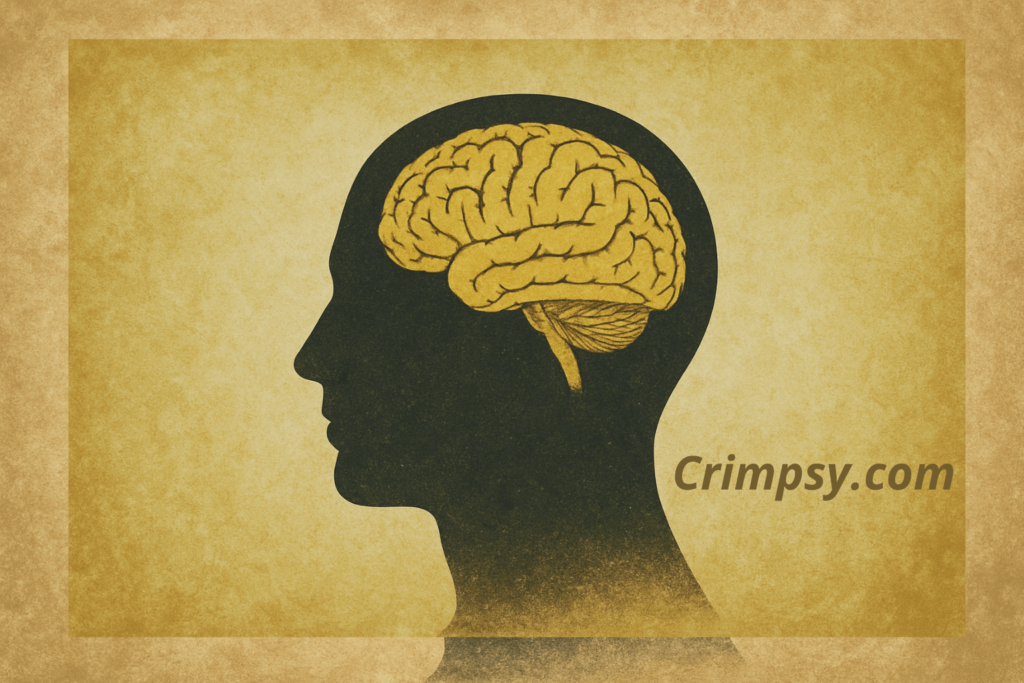Introduction
In criminology, the study of the relationship between mental disorders and criminal behavior has always represented one of the most complex and controversial fields of inquiry. Among the mental illnesses that have captured the attention of both criminologists and psychiatrists, schizophrenia stands out as a disorder that profoundly challenges our understanding of criminal responsibility, intent, and behavior.
Schizophrenia is a severe and chronic mental disorder characterized by disruptions in thought processes, perceptions, emotional responsiveness, and social interactions. It affects approximately 1% of the world’s population and manifests through symptoms such as hallucinations, delusions, disorganized speech, and impaired cognitive functioning. From a criminological perspective, this disorder raises essential questions about the extent to which mental illness contributes to criminal behavior, and whether individuals suffering from schizophrenia should be held legally and morally accountable for their actions.
Historically, the association between mental illness and crime has evolved across different . The Classical School of criminology, represented by thinkers such as Cesare Beccaria, emphasized free will and rational choice in criminal conduct. In contrast, the Positivist School, represented by Cesare Lombroso, Enrico Ferri, and Raffaele Garofalo, shifted focus toward the biological, psychological, and social determinants of crime — including mental illness. Later, psychoanalytic perspectives, particularly those of Sigmund Freud, deepened the understanding of unconscious conflicts and emotional disturbances as potential roots of deviant behavior.
The central research question of this study can therefore be formulated as follows:
How does schizophrenia influence criminal behavior, and how have classical and modern criminological theories interpreted this relationship?
To address this question, the study will follow a structured analysis divided into three main parts:
- Understanding Schizophrenia and Its Relevance in Criminology – defining the disorder, its symptoms, and its connection to crime from a psychological and social standpoint.
- Criminological Interpretations and Theoretical Perspectives – examining how key thinkers like Lombroso, Ferri, Garofalo, and Freud conceptualized mental illness and deviant behavior.
- Modern Scientific and Legal Approaches to Schizophrenia and Crime – analyzing recent developments in psychiatry, neuroscience, and legal systems in understanding offenders with schizophrenia.
I. Understanding Schizophrenia and Its Relevance in Criminology
1. Conceptual Definition of Schizophrenia
Schizophrenia is derived from the Greek words schizo (split) and phren (mind), indicating a fragmentation of thought and emotion. However, contrary to popular misconceptions, schizophrenia does not imply a “split personality.” Rather, it represents a profound disruption of cognitive and affective functions.
According to the Diagnostic and Statistical Manual of Mental Disorders (DSM-5), the main criteria for diagnosis include delusions, hallucinations, disorganized speech, grossly disorganized behavior, and negative symptoms such as emotional flatness or social withdrawal. These symptoms vary in intensity and duration but often result in severe impairment of social and occupational functioning.
From a criminological perspective, schizophrenia is particularly significant because certain symptoms — such as delusional thinking or command hallucinations — can lead to actions that are criminal in form but psychotic in origin. The individual may commit an offense under the influence of a hallucinated “voice” or a paranoid delusion, without rational understanding of the act.
2. Statistical and Empirical Observations
Empirical research has shown that individuals diagnosed with schizophrenia are not inherently violent; most are non-violent and more likely to be victims than perpetrators. However, when violence does occur, it is often associated with acute psychotic episodes, lack of treatment, substance abuse, or social marginalization.
Studies conducted in forensic psychiatry indicate that approximately 5–10% of violent crimes are committed by individuals with severe mental disorders, with schizophrenia being one of the most represented diagnoses. Yet, this must not lead to stigmatization — the majority of people with schizophrenia live peacefully when properly treated.
3. The Criminological Relevance
The study of schizophrenia in criminology bridges psychopathology and criminal behavior, aiming to understand whether crime arises from mental illness itself or from the social conditions surrounding it. It also invites discussion about responsibility and punishment, central concepts in both criminal law and criminology.
This intersection leads us to reconsider the concept of the “criminal mind.” Is criminal behavior in schizophrenic individuals truly a matter of willful deviance, or is it a manifestation of a disturbed mental state that requires treatment rather than punishment? This question has been at the core of criminological thought since the nineteenth century.

II. Criminological Interpretations and Theoretical Perspectives
1. Cesare Lombroso and the Biological View
Cesare Lombroso (1835–1909), the founder of the Italian Positivist School, was among the first to link mental disorders with criminality. In his seminal work L’Uomo Delinquente (The Criminal Man), Lombroso proposed that criminals could be identified by physical and psychological anomalies — a concept known as atavism.
While Lombroso focused primarily on hereditary and physical traits, he also acknowledged the presence of “mad criminals” (criminali folli), individuals whose crimes resulted from mental diseases such as epilepsy, hysteria, or psychosis. For Lombroso, these “insane criminals” represented a distinct category, separate from the born criminal or the occasional offender.
In his later writings, Lombroso recognized schizophrenic symptoms (though the term was not yet coined) as possible causes of criminal acts beyond the individual’s control. He argued that mental illness neutralizes moral sense and rational judgment, rendering the offender more an object of medical care than punishment.
Thus, Lombroso opened the door for psychiatric interpretations of crime, emphasizing biological and psychological abnormalities as determinants of deviant conduct.
2. Enrico Ferri and the Multifactorial Theory
Enrico Ferri (1856–1929) expanded Lombroso’s ideas through his theory of multiple causes (teoria delle cause multiple). Ferri viewed crime as a product of the interaction between biological, psychological, and social factors. He argued that mental disorders, including psychoses like schizophrenia, play a significant role in shaping antisocial behavior when combined with environmental stressors.
For Ferri, the law should adapt to the offender’s mental and social condition, not merely the act committed. He promoted a system of social defense, suggesting that individuals with mental disorders should be treated in specialized institutions rather than prisons.
This approach marked a significant transition toward the modern concept of criminal responsibility, where mental illness is recognized as a mitigating or exempting factor in criminal proceedings.
3. Raffaele Garofalo and the Moral Dimension
Raffaele Garofalo (1851–1934) introduced the idea of the “natural crime” (delitto naturale), defining criminal behavior as acts contrary to universal sentiments of pity and probity. For Garofalo, the essence of criminality lies in the absence of moral sensitivity rather than legal transgression alone.
From this standpoint, mental disorders like schizophrenia could erode moral emotions, leading to antisocial acts. However, Garofalo maintained that not all insane individuals were morally deprived; only those whose psychological impairment destroyed the natural moral sense could be considered “true criminals.”
Garofalo thus combined legal and moral criteria in explaining the relationship between insanity and crime, contributing to the emergence of the concept of moral insanity, a precursor to modern understandings of psychopathy and personality disorders.
4. Sigmund Freud and the Psychoanalytic Perspective
Sigmund Freud (1856–1939) offered a radically different interpretation through psychoanalysis, focusing on unconscious drives, repression, and internal conflicts. In Freud’s view, crime can emerge as a symbolic expression of unresolved psychic tensions — a “return of the repressed.”
While Freud did not directly study schizophrenia in criminological terms, he described it as a severe form of ego disintegration, where the boundary between internal and external reality collapses. The schizophrenic’s actions may thus represent an attempt to restore psychic coherence, even through irrational or aggressive behavior.
Later Freudian criminologists, such as Alexander and Staub (1931), linked criminal acts in psychotic individuals to unconscious guilt, self-punishment, or defense against inner anxiety. This psychoanalytic tradition continues to influence modern forensic psychiatry, emphasizing that behind every criminal act may lie a psychic conflict rather than mere criminal intent.
III. Modern Scientific and Legal Approaches to Schizophrenia and Crime
1. The Neurobiological and Psychological Dimension
Modern neuroscience has deepened our understanding of schizophrenia, revealing structural and functional brain abnormalities — particularly in the prefrontal cortex and limbic system — that affect decision-making, impulse control, and emotional regulation.
These findings challenge traditional legal notions of mens rea (criminal intent), as they show that some offenders may act without full cognitive awareness or moral discernment. Functional MRI studies have shown diminished activation in brain regions responsible for empathy and reasoning, supporting earlier positivist hypotheses in a scientific context.
2. The Socio-environmental Context
Sociological criminology complements this picture by examining how social exclusion, poverty, and stigma exacerbate criminal risks among individuals with schizophrenia. Lack of access to mental health care, homelessness, and exposure to substance abuse significantly increase vulnerability to both offending and victimization.
Modern criminological models therefore advocate integrative approaches that combine medical treatment, social support, and rehabilitative justice rather than punitive measures.
3. Forensic Psychiatry and Criminal Responsibility
Today, most legal systems recognize that severe mental disorders, including schizophrenia, can diminish or abolish criminal responsibility. The principle of insanity defense (or not guilty by reason of insanity) reflects this recognition.
However, forensic psychiatry now aims to balance social protection with individual rights, emphasizing early intervention, risk assessment, and therapeutic justice. This perspective echoes Ferri’s and Lombroso’s belief that prevention and rehabilitation are more effective than punishment.
Conclusion
The relationship between schizophrenia and criminal behavior reveals the complex interplay between mental illness, biology, psychology, and society. From Lombroso’s biological determinism to Ferri’s multifactorial model, Garofalo’s moral reasoning, and Freud’s psychoanalytic insight, criminological thought has progressively evolved toward a nuanced understanding of the mentally ill offender.
Modern science confirms that while schizophrenia may contribute to certain criminal acts, it does not define the individual as a criminal. The true challenge for criminology and criminal justice lies in distinguishing disease-driven behavior from deliberate wrongdoing, and in ensuring that justice systems remain humane, scientific, and equitable.

References
- Lombroso, C. L’Uomo Delinquente. Turin: Bocca, 1876.
- Ferri, E. Criminal Sociology. New York: Appleton, 1895.
- Garofalo, R. Criminologia. Turin: Bocca, 1885.
- Freud, S. Introductory Lectures on Psychoanalysis. 1916–1917.
- American Psychiatric Association. Diagnostic and Statistical Manual of Mental Disorders (DSM-5). 2013.
- Hodgins, S. “Mental Disorder, Intellectual Deficiency, and Crime.” Science, vol. 264, 1994.
- Taylor, P. J., & Gunn, J. “Violence and Psychosis.” British Journal of Psychiatry, 147(6), 1985.
- Fazel, S., & Grann, M. “The Population Impact of Severe Mental Illness on Violent Crime.” American Journal of Psychiatry, 2006.
- Raine, A. The Anatomy of Violence: The Biological Roots of Crime. Pantheon Books, 2013.
- Sigmund Freud’s Theory in Criminology – Crimpsy.com
- Enrico Ferri and the Theory of Multiple Causes – Crimpsy.com

